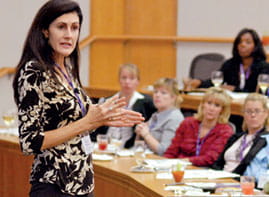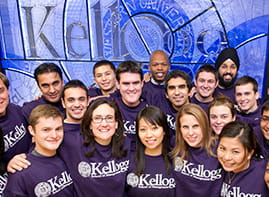3/14/2016 - A team of ten Kellogg faculty and administrators was invited for an extended visit to the Army’s National Training Center at Fort Irwin February 26-28. Located in the Mojave Desert in southern California and central to the success of the U.S. Army and our nation’s security, it’s a place that only a select few beyond the Army soldiers and personnel stationed there ever see.
“Soldiers who soon will be deployed overseas are essentially deployed to Fort Irwin first,” explains Kellogg Army fellow Col. Brian Halloran, who joined the group and has trained there himself.
The visit came about as a result of Kellogg’s unique partnership with the Army, which began with its first Senior Fellow in 2012, Col. (retired)
Robert Hughes. The only business school with such a relationship, Kellogg has hosted three additional Army fellows since then, each of whom has brought new perspectives and insights for faculty and students alike.
“Most people assume that a top business school and a nation’s leading military operation have little in common,” says Halloran, “but we are far more similar than meets the eye, and we have much to learn from each other.”
This is not the first time Kellogg has been granted the privilege of peering behind the Army’s typically tightly drawn curtain.
“We’d brought Kellogg faculty to visit the Pentagon a couple of times,” says Hughes, referring to trips that took place in 2014 and 2015, “and Brian [Halloran] and I wanted to give them an exclusive view from an operational perspective. We saw it as a potential learning opportunity for all.”
Desert Training, Army Style
Roughly the size of Rhode Island, the training grounds include replicas of towns with schools, markets, factories, and other common buildings to create a realistic setting. Cameras and microphones are strategically embedded throughout the area to capture the action for later review—and scrutiny.
“During training, soldiers are engaged in maneuvers against a free-thinking enemy who is familiar with the terrain,” says Halloran. “After every significant event, the brigade holds a deliberate after-action review process, where they discuss what happened, the decisions they made and how they can improve next time. The idea is to make mistakes, learn and grow in a safe, dynamic, realistic environment.”
Will Garrett, associate dean of Executive Education, agrees. “There is a massive focus on teamwork during the training; on how to communicate effectively and use the collective brainpower of the unit.”
During the review process, brigade commanders turn a critical eye toward themselves, and begin their comments with, “What I failed to do was …” which helps build an environment of leadership accountability.
“It was sobering,” said
Bob McDonald, senior associate dean of faculty and research and Erwin P. Nemmers professor of finance, of the after-action review process. “There was no hiding, no mumbling. The leaders had to own the results.”
Always Improving
A reflection of the Army’s interest in continuous improvement, the Kellogg team was encouraged to ask questions and offer insights in response to what they’d seen, and were granted unfettered access to anyone they wished. The results were favorable for both sides.
“Several training center personnel have contacted me with positive comments about the group’s visit,” Halloran says. “It was great for the Fort Irwin teams to receive feedback from such a diverse group of scholars.”
One key area the training center wants to explore further as a result of the visit is how they can better use the data they collect during training to detect and address patterns between brigades. In turn, having experienced leadership training within an entirely different context and at a new level of intensity, the Kellogg team returned with a broadened perspective.
“Fort Irwin has a true culture of learning,” says
Holly Raider, managing director of Executive Education and clinical professor of management. “They’re equipping leaders with an unexpected quality of humility and openness to the idea that the best answers don’t always sit with one individual. That’s an important leadership lesson for us all.”






